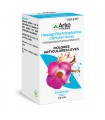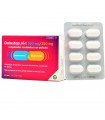CONTRAINDICATIONS
- Hypersensitivity to any of the ingredients of the medicine.- Pregnancy and lactation.- [HYPERVITAMINOSIS A].- Severe hepatic or renal impairment.- Children under 14 years of age (due to their dosages and pharmaceutical form).
PREGNANCY
Vitamin A needs may increase during pregnancy. However, daily doses greater than 6,000 U.I./day are not recommended. Fetal abnormalities, stunted growth and premature closure of epiphysis have been reported in children whose mothers took excessive amounts of vitamin A during pregnancy. This medicine is contraindicated during pregnancy and in women with the possibility of becoming pregnant.
INDICATIONS
- [VITAMIN A DEFICIT] and [VITAMIN E DEFICIT] caused by insufficient diet, convalescences or other reasons; to promote the general state, among other actions, of vision, skin, mucous membranes and defenses.
INTERACTIONS
- Vitamin A analogues (acitretin, bexarotene, etretinate, isotretinoin, tretinoin): possible increased risk of vitamin A toxicity from additive effects; it's becauseprevent their concomitant use with these medicines.- Cumarin anticoagulants: possible increase of anticoagulant effect, with an increased risk of bleeding; and with large doses of vitamin E concomitantly can prolong the time of prothrombin. Monitor prothrombin time.- Parenteral anticoagulants (e.g. abciximab, human antithrombin III, fondaparinux, heparin): concomitant administration with vitamin A may cause an increase in anticoagulant effect, withincreased risk of bleeding.- Antiplatelet agents (e.g. clopidogrel, eptiibatide, tyrofiban): concomitant administration with vitamin A may cause an increase in anticoagulant effect, with increased risk of bleeding.- Minocycline (tetracycline): possible additive toxicity with vitamin A, with probable increased risk of benign intracranial hypertension (brain pseudotumor).- Cholestyramine, colestipol: possible reduction of absorption of fat-soluble vitamins. Administration should be spaced as much as possible.- Orlistat: could reduce GI absorption of fat-soluble vitamins such as A and E; it is recommended to separate your administration for at least 2 hours.- Mineral or parafina oil: may affect the absorption of vitamins A and E.- Oral contraceptives: Simultaneous use with vitamin A may increase plasma concentrationsvitamin.- Oral neomycin: could reduce the absorption of vitamin A.- Iron supplements: large doses of iron can catalyze oxidation and possibly increase daily vitamin E requirements.
BREAST FEEDING
Contraindicated during lactation.
RULES FOR PROPER ADMINISTRATION
Orally. The capsules should be taken with the help of some water or other liquid, preferably with food.
DOSAGE
- Adults and children over 14 years: 1 capsule/24 h. In certain cases, 1 capsule/8-12 h.
They should not be exceeded 10 days of treatment without consulting with the doctor if symptoms get worse or do not improve. Treatment should generally not exceed two weeks.
"Strong": The recommended dose is one capsule/24 h. Treatment should generally not exceed two weeks.
* Severe vitamin A deficiency: 2 capsules (100,000 IU vitamin A) per day for 3 days, followed by 1 capsule (50,000 IU vitamin A) per day for 2 weeks. Maintenance: switch to Auxina A+E lower dose capsules (contains 5,000 IU vitamin A and 10 mg vitamin E); 2-4 capsules/day are recommended for 2 months.
* Active Xerophthalmia: 4 capsules, immediately after diagnosis is established; the next day another dose of 4 capsules will be given and at least 2 weeks later, a third dose of another 4 capsules will be administered.
PRECAUTIONS
- Doses higher than recommended should not be administered.
- If fat-soluble vitamins, such as A and E, especially vitamin A, are taken in excess (high doses and/or for extended periods) side effects may occur, as these are usually associated with hypervitaminosis. Over-administered vitamin A can cause toxicity.
- [RENAL INSUFFICIENCY], [HEPATIC INSUFFICIENCY]: have an increased risk of vitamin A toxicity. Caution is required prior to administration to these patients, considering the balance sheet
risk/benefit.
- The risk of vitamin A toxicity may also increase in case of low body weight, protein malnutrition, hyperlipoproteinemia, patients with hypertriglyceridemia, alcohol consumption or vitamin C deficiency.
- In patients predisposed or exposed to [TROMBOFLEBITIS], high-dose vitamin E increases the risk of developing the disease.
- High doses of vitamin E may exacerbate clotting defects in individuals with vitamin K deficiency or who are being treated with anticoagulants.
PRECAUTIONS RELATING TO EXCIPIENTS
- This medicine contains orange yellow S as an excipient. May cause allergic reactions including [ASMA], especially in patients with [SALICILATOS ALLERGY].
ADVERSE REACTIONS
- Blood and lymphatic system: (<1%): I[LINFADENITIS].
- Nervous system: (<1%): [CEFALEA].
- Eyepieces: (<1%): [NISTAGMO].
- Gastrointestinal: (<1%): [ANOREXIA], [NAUSEAS], [DIARREA], [EPIGASTRICO PAIN], intestinal spasms.
- Musculoskeletals: (<1%): Pain and [MIASTENIA].
- General: (<1%): [ASTENIA].
- Psychiatric: (<1%): [HUMOR ALTERATIONS], [IRRITABILITY].
Hypervitaminosis or hypersensitivity: Persistent anorexia, vomiting, headaches, irritability, hepatomegaly, intracranial hypertension, muscle weakness, fatigue.
ADVERSE REACTIONS RELATED TO EXCIPIENTS
- Containing orange yellow (E-110) may cause [HYPERSENSITIVITY REACTIONS].































